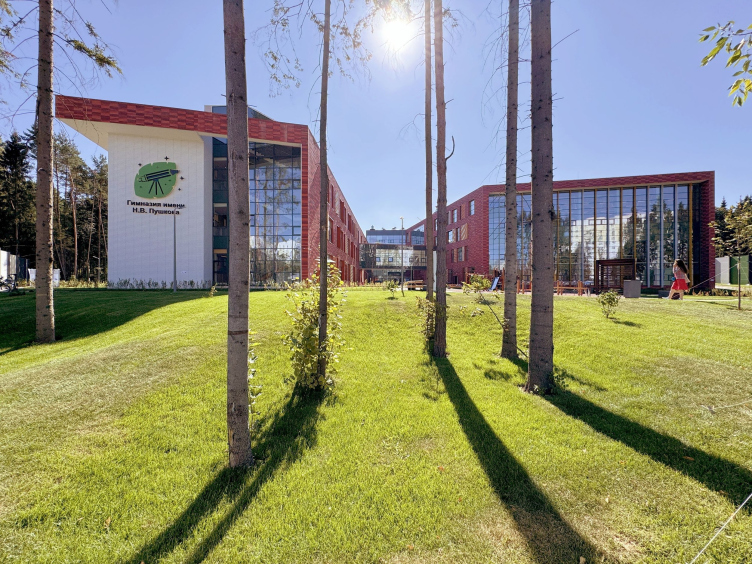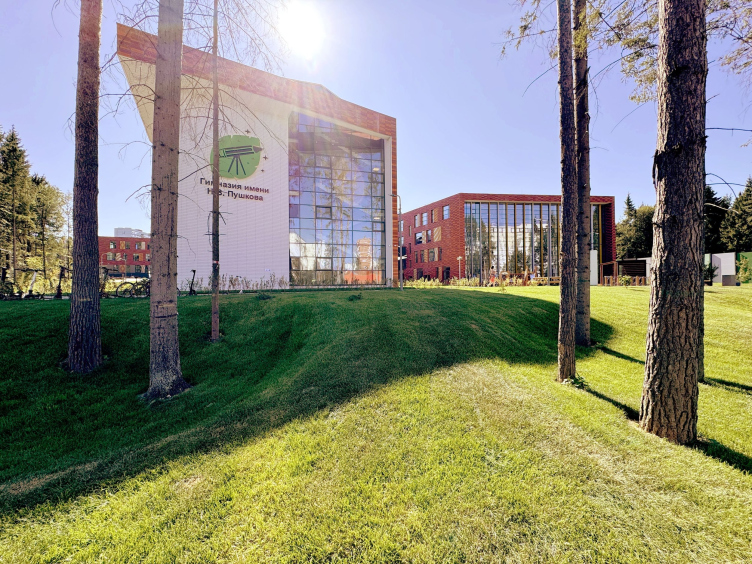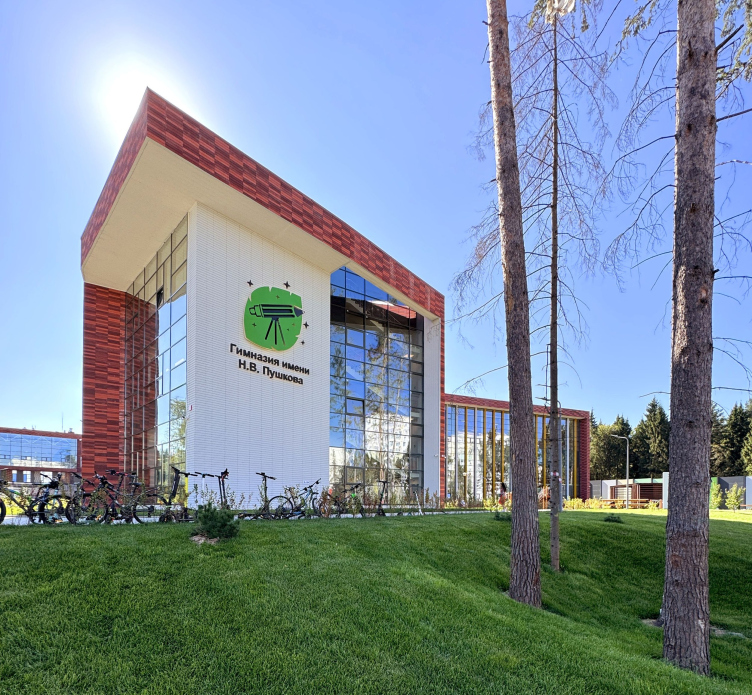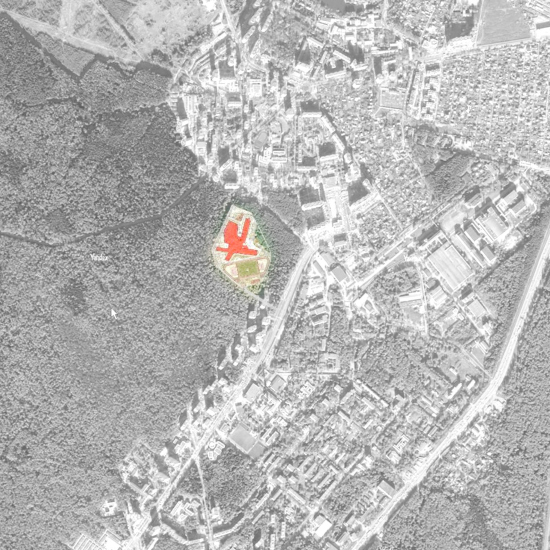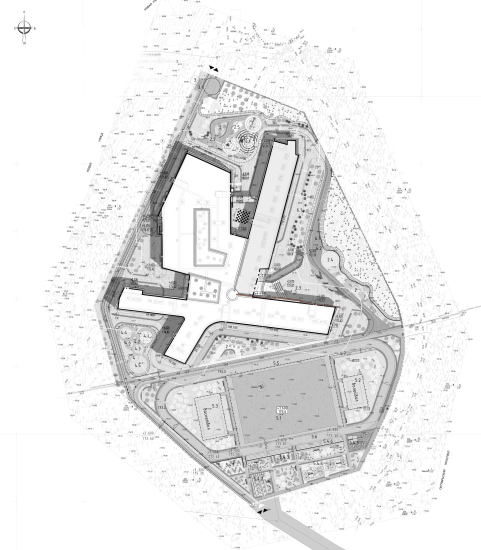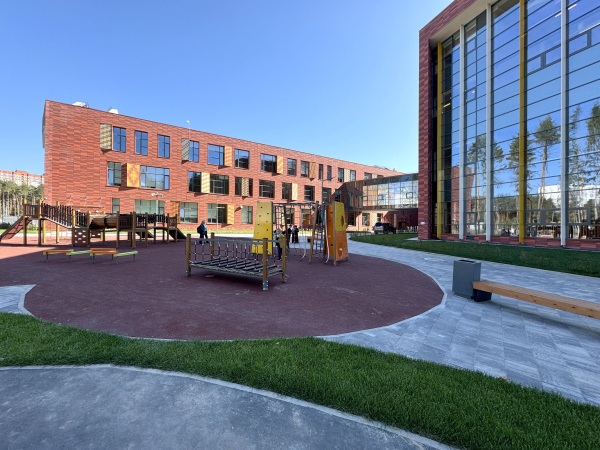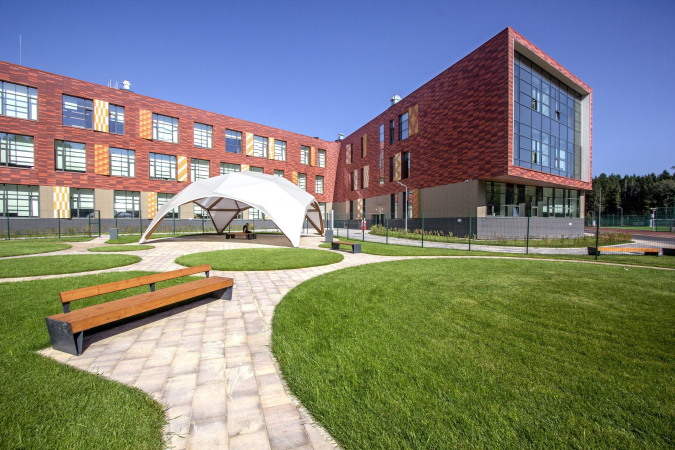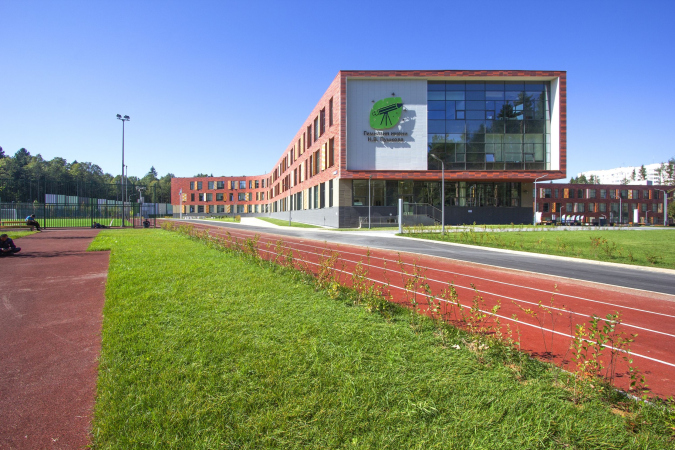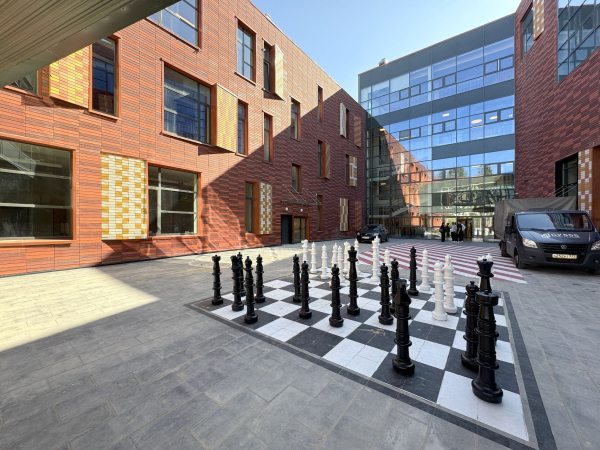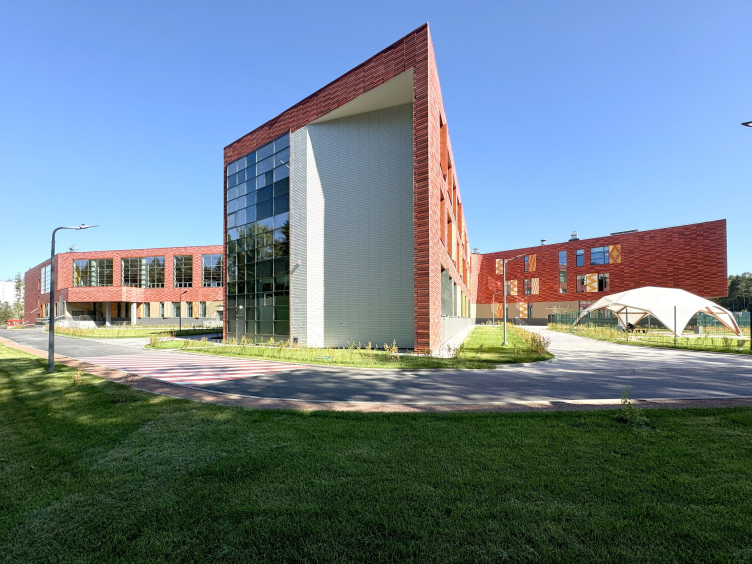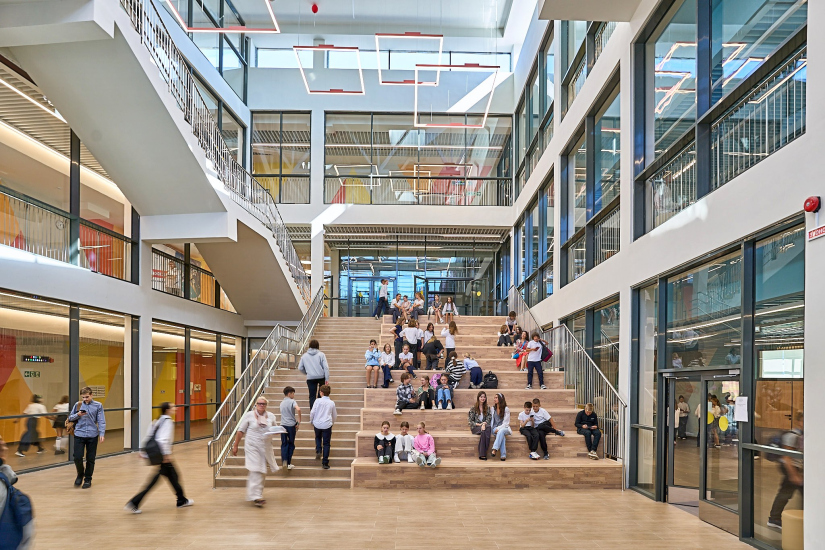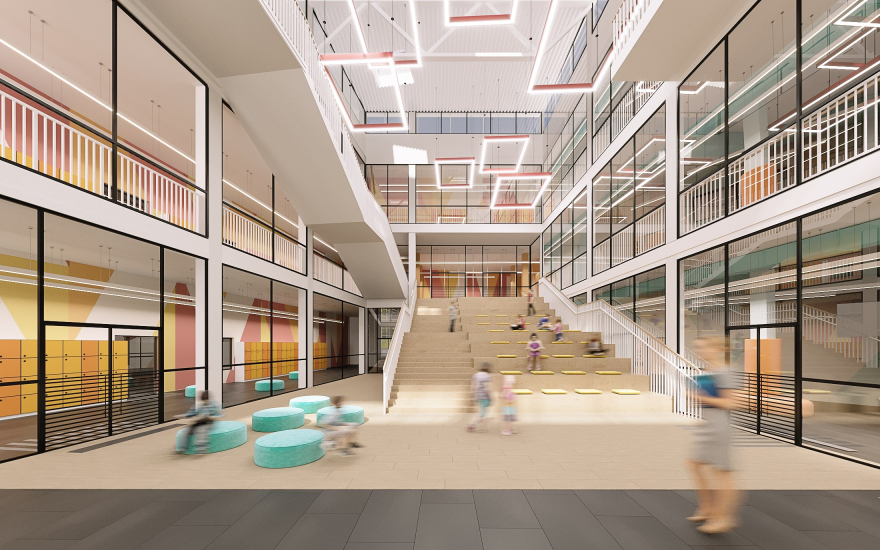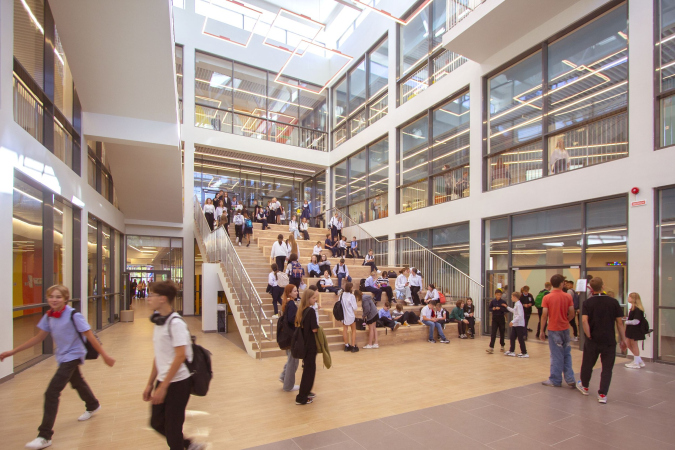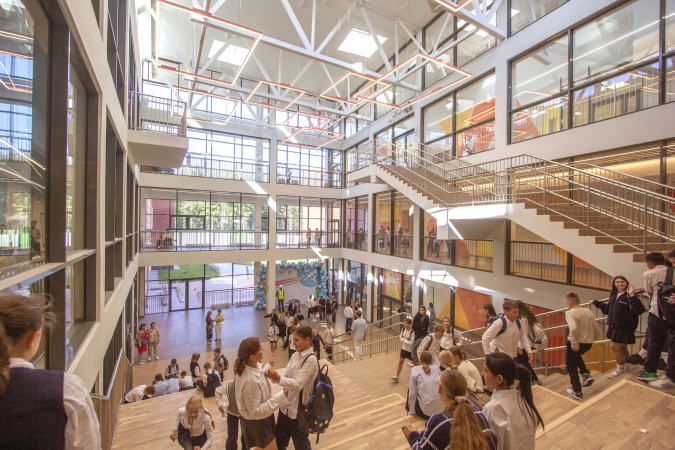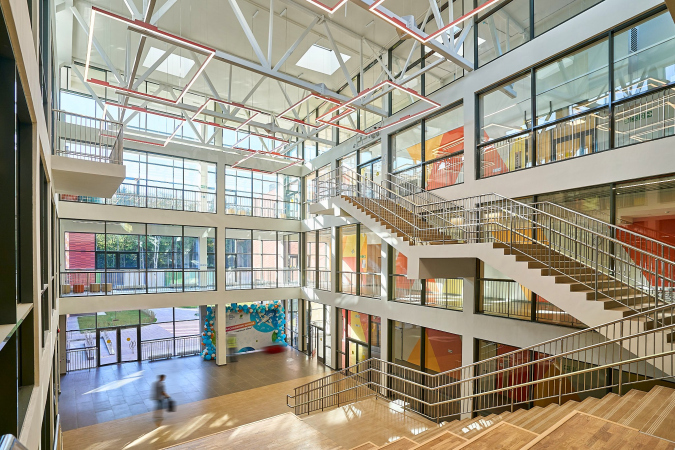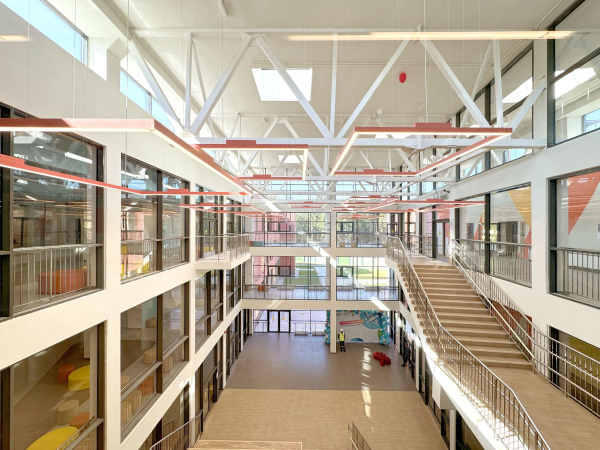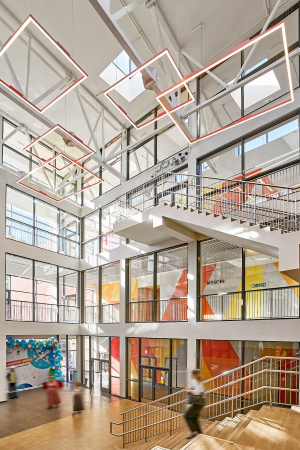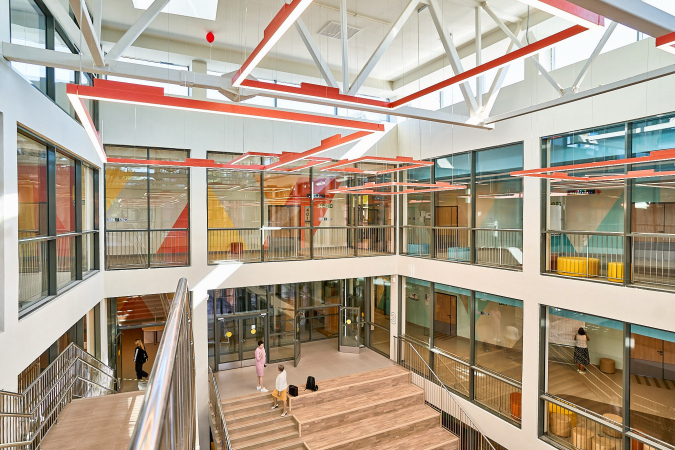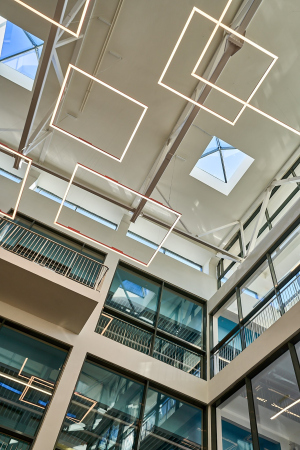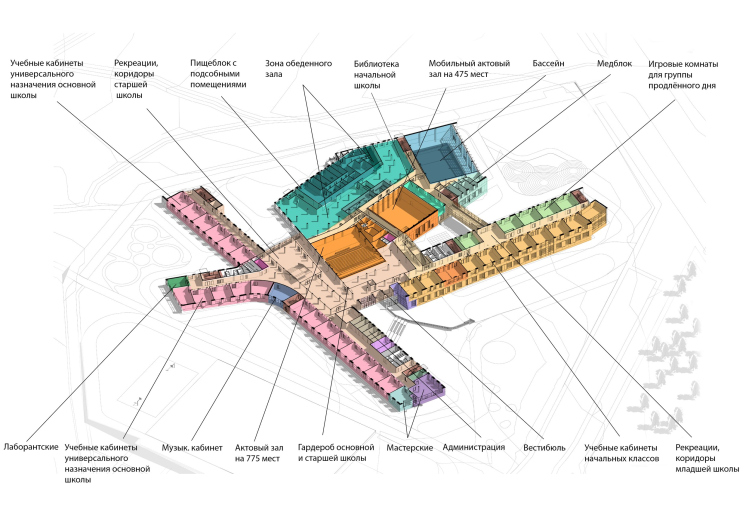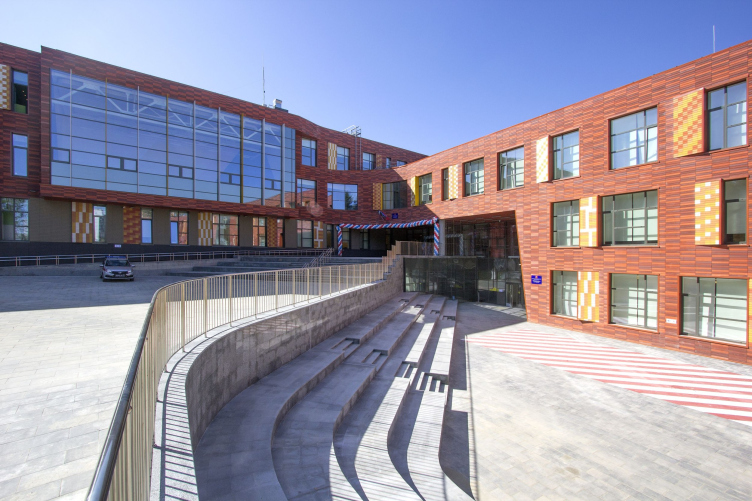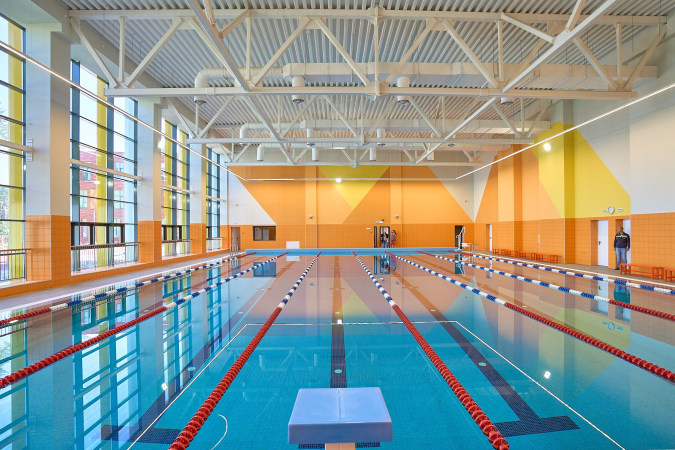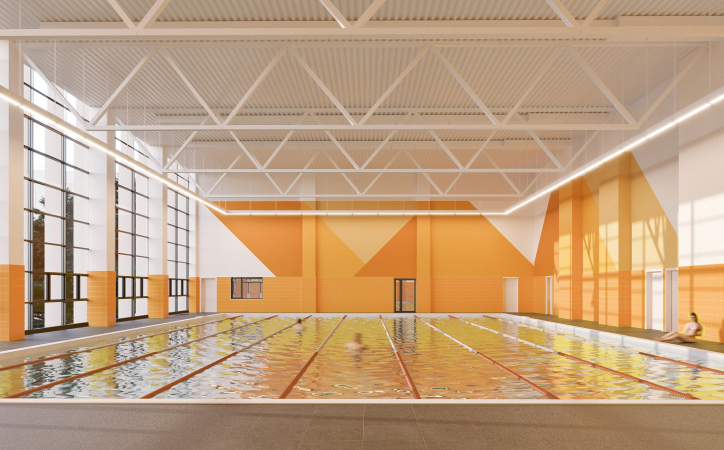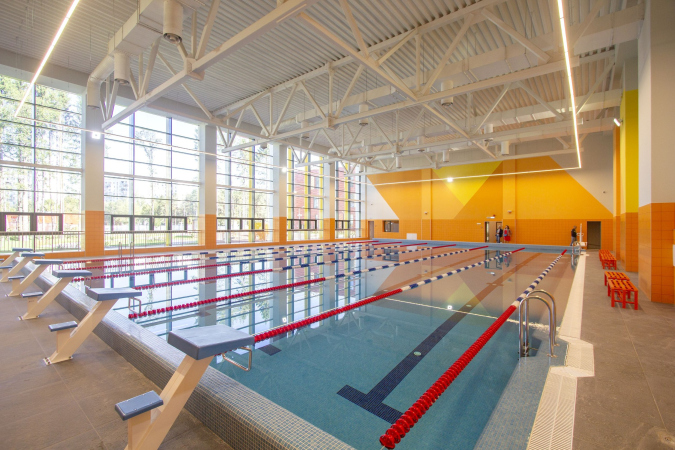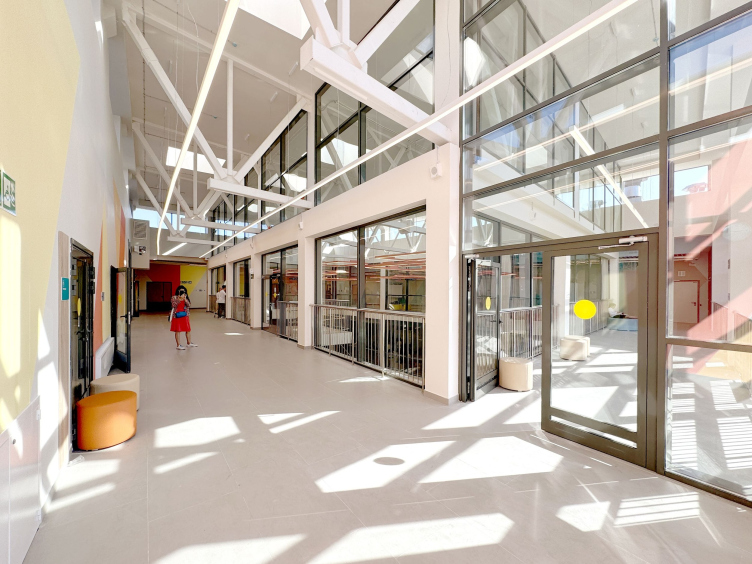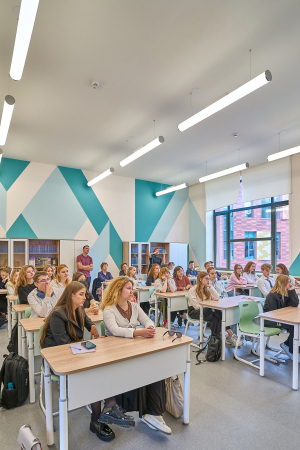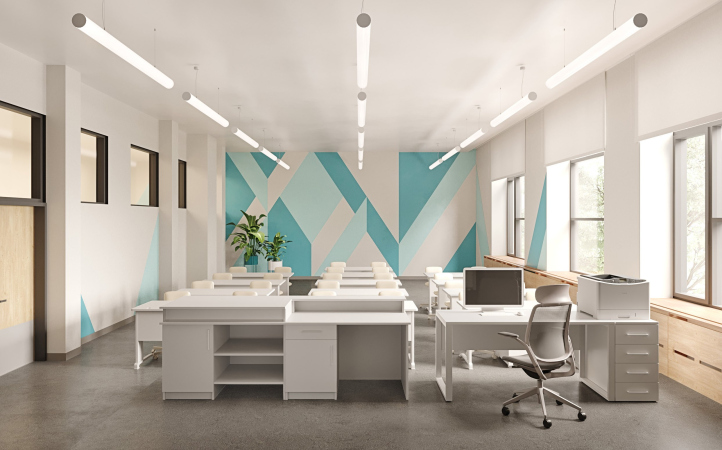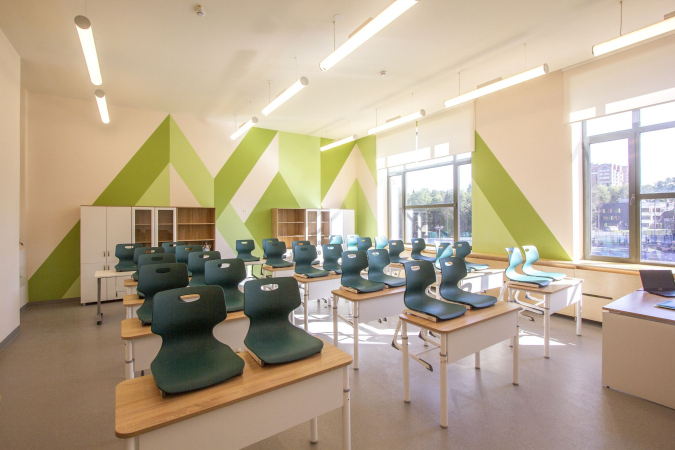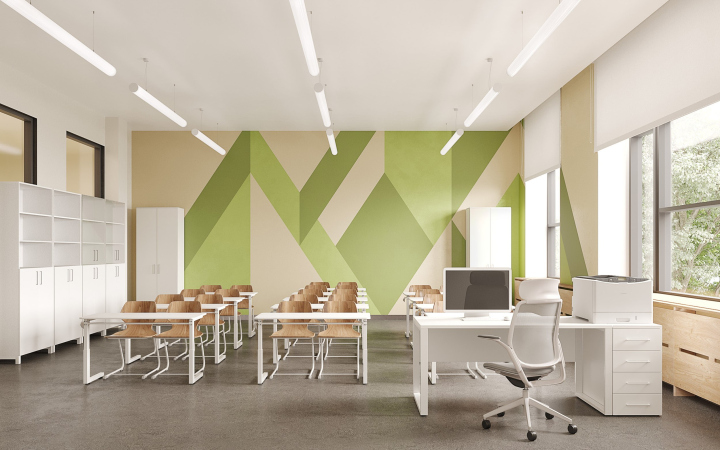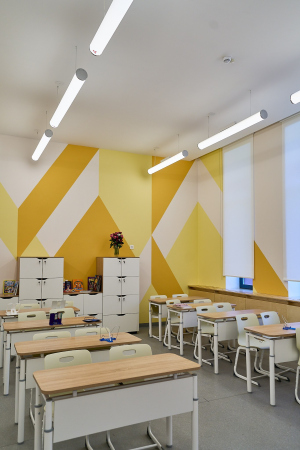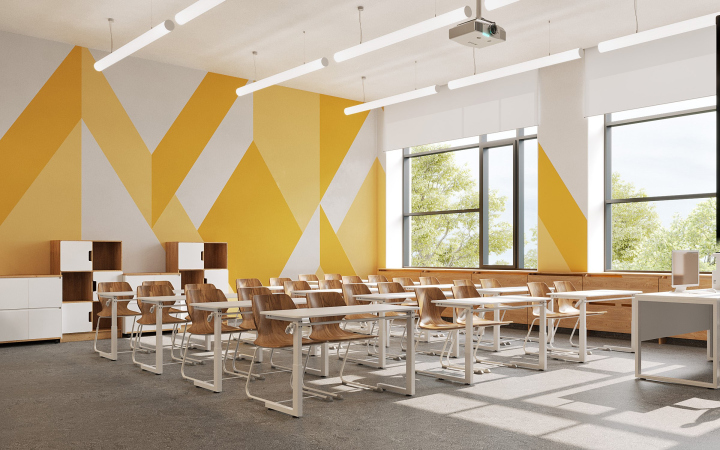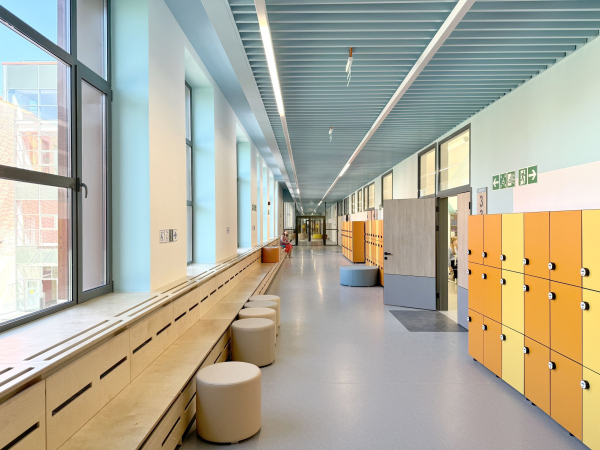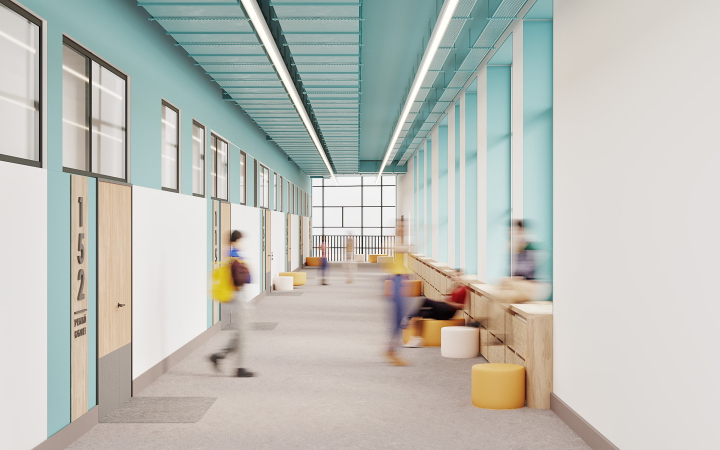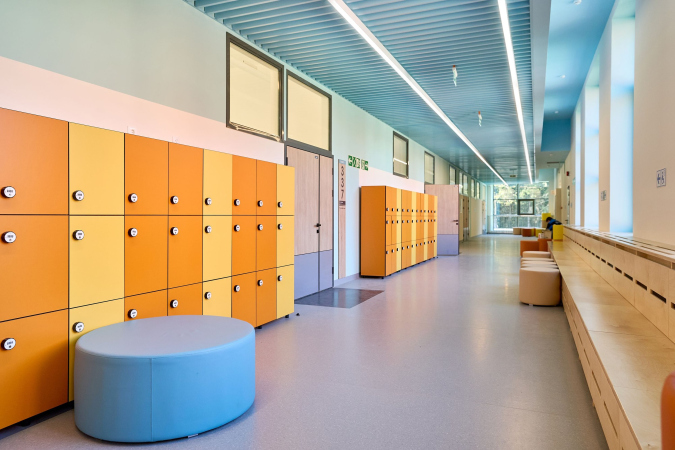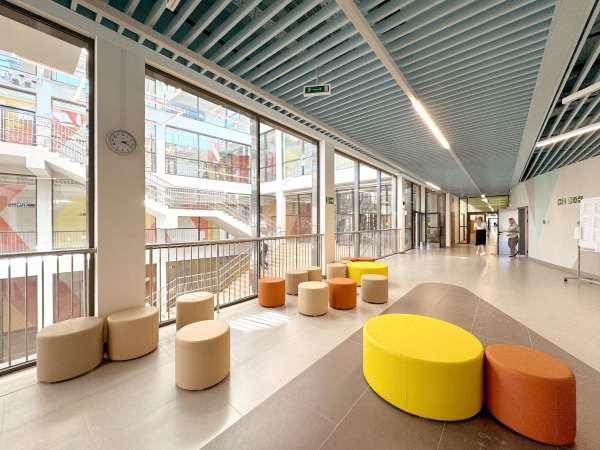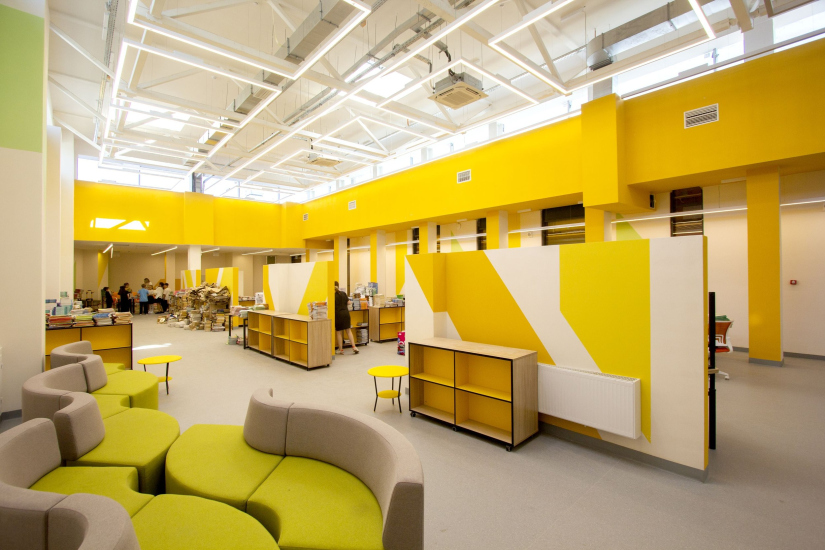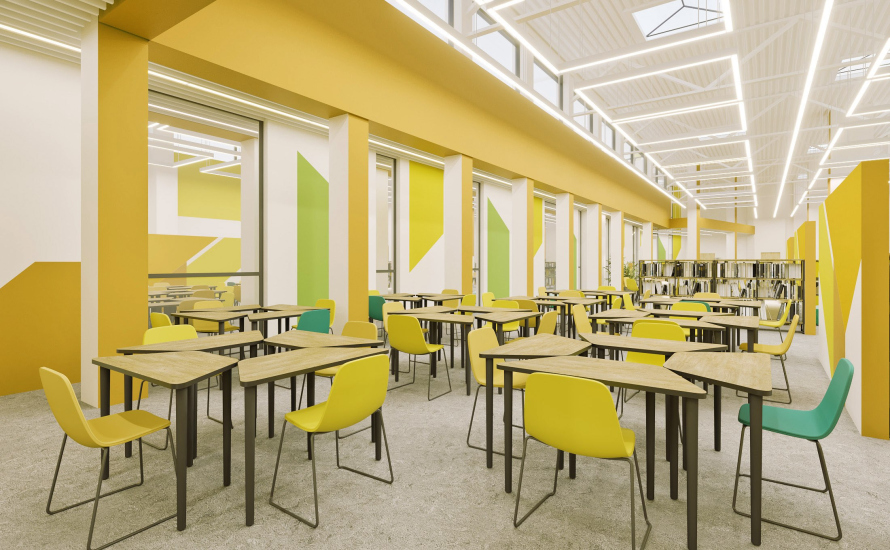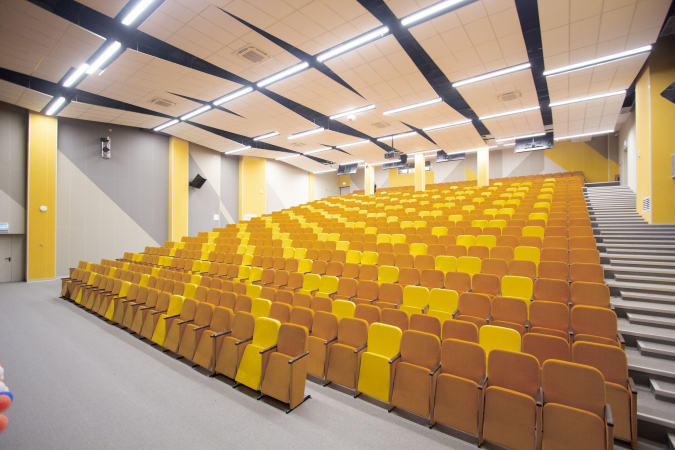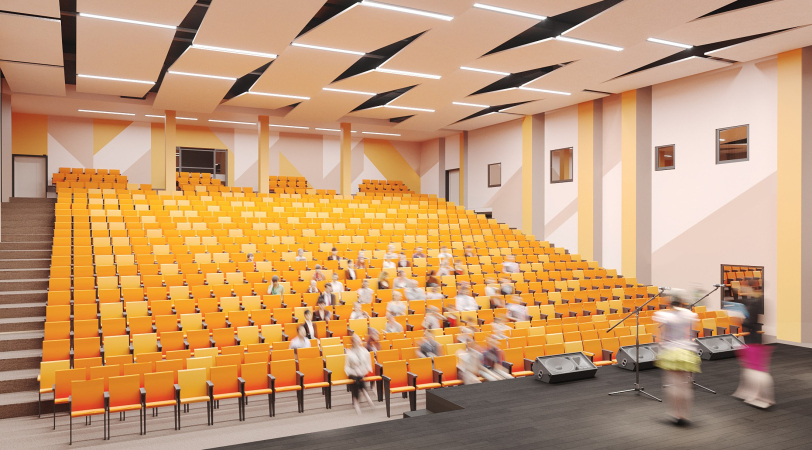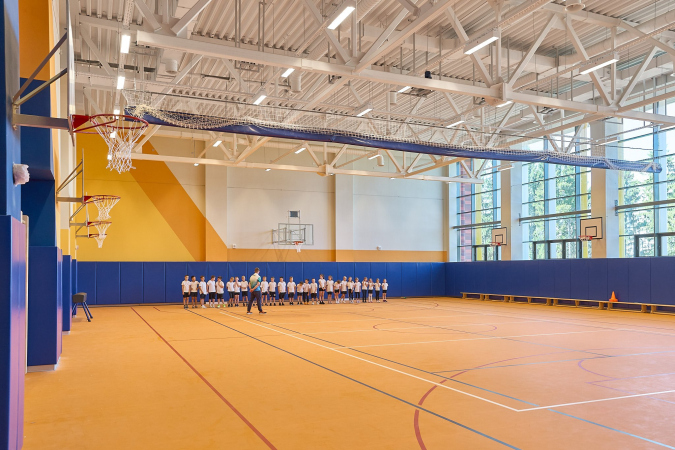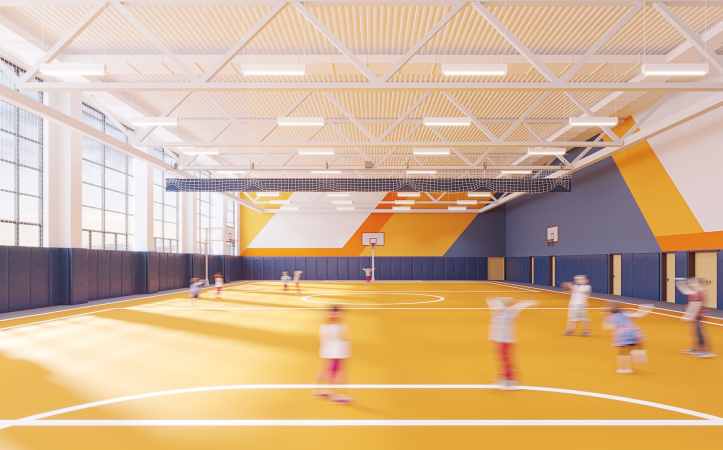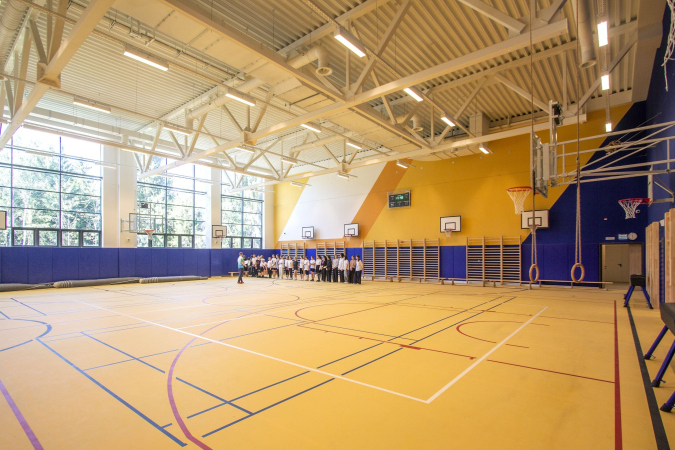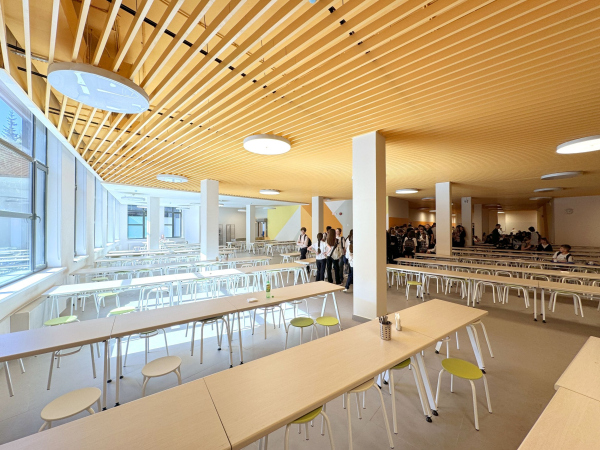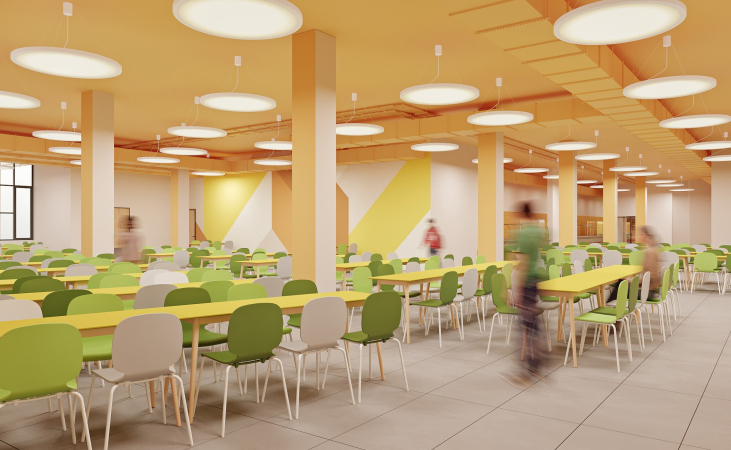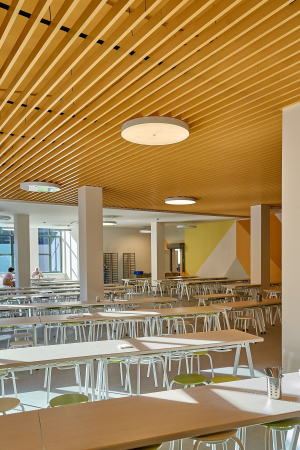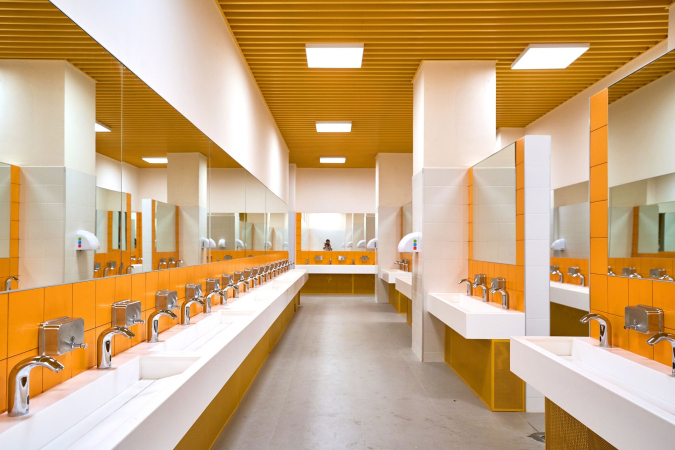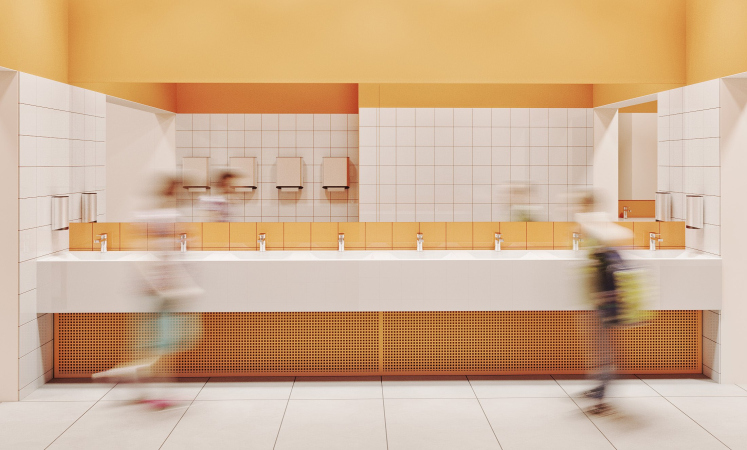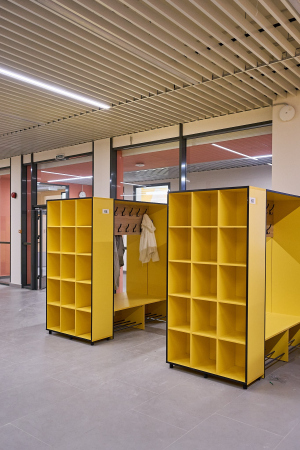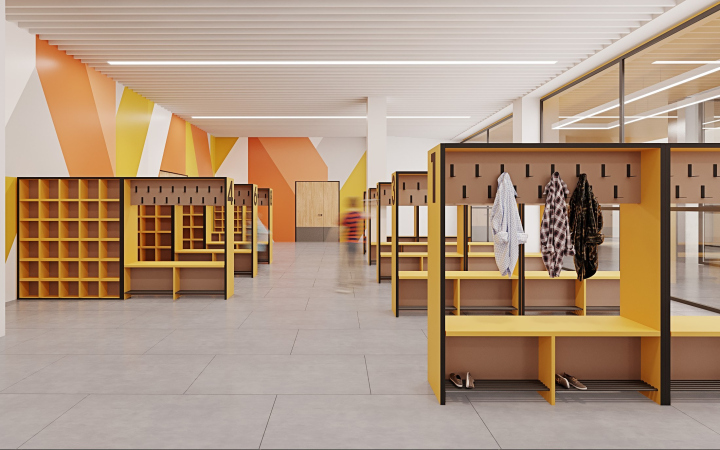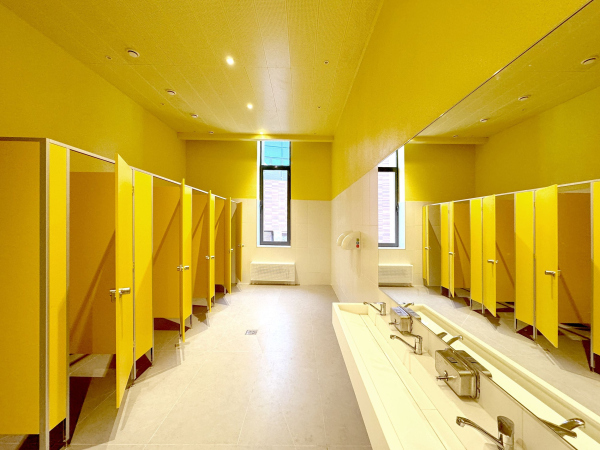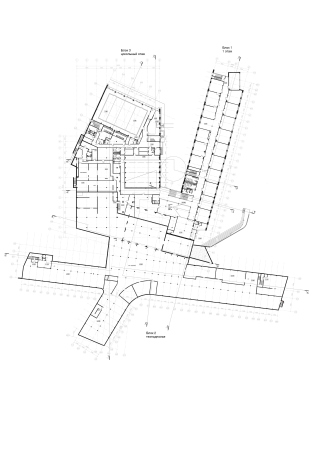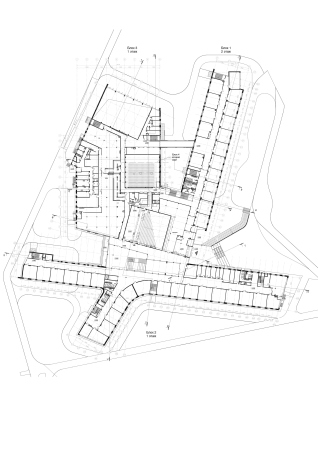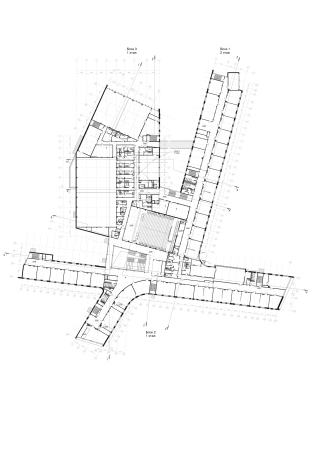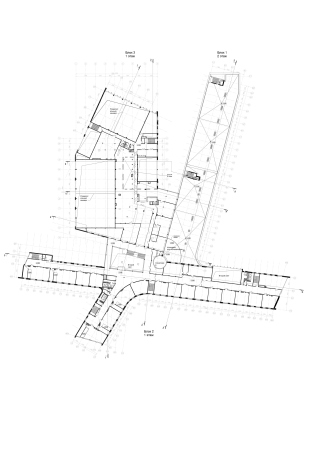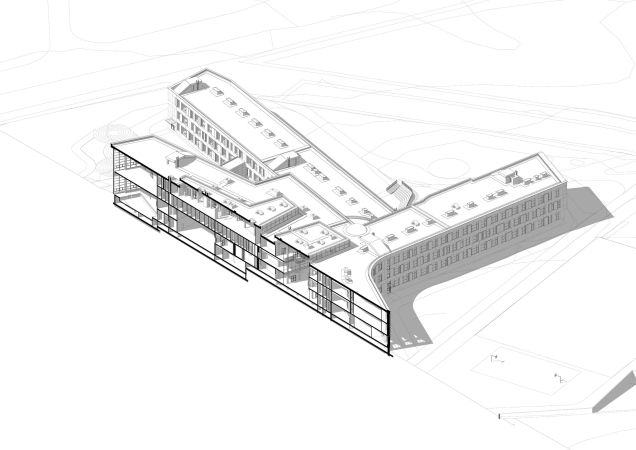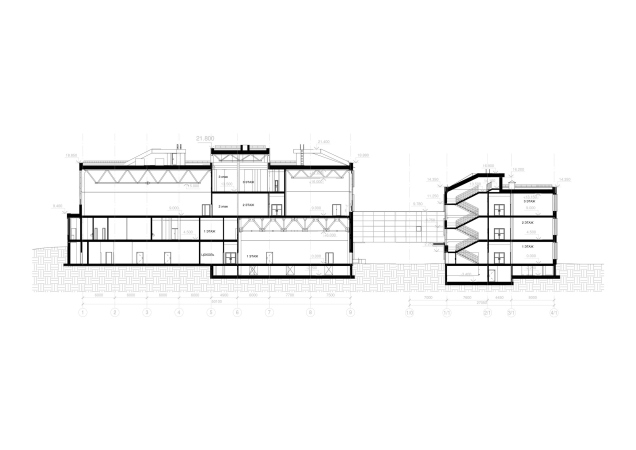Fortunately, the Troitsk school project (read more about it here) was implemented with minimal alterations. This was made possible by the architects’ persistence and ingenuity, the support of the Moscow Department of Education and Science, and the school administration, as well as a compelling argument – the Moscow Mayor’s Prize in Architecture, awarded to the design team back in 2020.
It is interesting to trace which design solutions were successfully implemented, which had to be adjusted, and how they have performed in practice during the school’s first six months of operation. To help readers compare and identify the differences between the project and its realization, we have included several visualizations alongside photographs in this publication.
View of the school from the forest
Copyright: Photograph © Andrey Asadov / provided by ASADOV Architects
Amidst the Trees
The school was built on a site within a forested area, which sparked prolonged and heated conflicts with local residents protesting against tree cutting and the closure of a walking trail. To mitigate the conflict and minimize the environmental impact, the architects and designers had to carefully select the construction footprint, considering not only the required fire safety setbacks but also the trail’s path and underground utilities.
Later on, it was ultimately decided to dismantle the underground utilities. As for the trail, the landscaping project included a designated pathway that now divides the school grounds into a sports area and the main building. Gates were installed on both sides of the path, but, paradoxically, safety regulations require them to remain closed.
View of the school from the forest
Copyright: Photograph © Andrey Asadov / provided by ASADOV Architects
The constraints on building footprint, the effort to preserve as many trees as possible, and the extensive and diverse functional requirements of the school all shaped an inventive layout. The result is a structure resembling either an asymmetrical leaf or a slightly disheveled starfish, with five “branches” extending from a central atrium block.
This distinctive configuration allowed for maximum natural lighting in the interior spaces. Moreover, the design takes full advantage of the surrounding forest, offering sweeping views through large facade windows and expansive glazed end walls.
One of the side ends with the school′s logo
Copyright: Photograph © Andrey Asadov / provided by ASADOV Architects
The importance of the forest setting is further emphasized in the facade treatment. The original design called for ceramic cladding in reddish-brown and yellow-orange hues, meant to echo the color of sunlit pine trunks. However, during the working design phase, budget constraints necessitated replacing the ceramic panels with smaller-scale concrete tiles embedded with marble chips. As a result, the facade design was adjusted – color shades and rhythm of alternation were modified – but the overall concept of an autumnal forest remained intact. The original angled facade elements, protruding from the main wall surface, were also preserved. Additionally, the facades are adorned with mosaic patterns reminiscent of those found in Soviet modernist architecture, creating a series of decorative motifs.
The switch to a smaller-scale cladding material had another unintended benefit: it helped conceal construction imperfections that emerged during the erection of monolithic and block walls. Some sections of the walls ended up warped in three dimensions, but the ventilated facade system largely managed to compensate for these irregularities, with varying degrees of success.
However, one issue that could not be rectified was the builders’ unconventional approach to installing the enamel-glass panels in the glazed sections. These panels were mounted with their decorative side facing inward. Interestingly, the architects noticed the mistake in time, but, following orders from an unidentified “boss” (no less!) the construction team continued installing them in reverse. Fortunately, incidents were few and far between.
A Space for Interaction
The star-shaped configuration of the school building was influenced not only by the specifics of the site but also by the architects’ intent to balance the initial goal of dividing the school into functional blocks with the need to create communal areas – spaces for relaxation and communication. The school building’s key feature fulfilling this role is the multi-story atrium situated at the junction of the blocks.
One of the side ends with stained glass glazing
Copyright: Photograph © Andrey Asadov / provided by ASADOV Architects
For today’s children, memorizing information is not as important as being able to find and use it, collaborating with others to go beyond the limits of your individual capabilities. A school can encourage communication, interaction, and collective creativity. From project to project, we explore the typology of schools, searching for new possibilities within it. That is why atrium spaces with amphitheaters, as well as spaces for informal communication, have become a key element of our new approach.
Another important theme is the “city” image: the atrium resembles a town square, specialized classrooms look like office centers, traditional classrooms resemble residential quarters, the auditorium and sports halls serve as public centers, while the corridors and staircases transform into thoroughfares and passageways. Even behavioral models within the school are structured in analogy with the social standards of an urban community.
We want to go further, turning schools into centers of public life in their neighborhoods. In Troitsk, we have partially achieved this, but further work is needed on typology and existing standards.
Another important theme is the “city” image: the atrium resembles a town square, specialized classrooms look like office centers, traditional classrooms resemble residential quarters, the auditorium and sports halls serve as public centers, while the corridors and staircases transform into thoroughfares and passageways. Even behavioral models within the school are structured in analogy with the social standards of an urban community.
We want to go further, turning schools into centers of public life in their neighborhoods. In Troitsk, we have partially achieved this, but further work is needed on typology and existing standards.
The complex functional layout of the school posed challenges for planning. Special attention was given to ensuring that younger students could be separated from the upper grades when necessary. Separate entrances were provided, and interior doors allow flexible zoning within the building. The junior-school children have their own section of the cafeteria and even a designated “junior” area in the library. However, after the school actually opened, the administration decided not to enforce strict separation – a decision that proved convenient for everyone.
There were even instances where younger students got lost, and the older ones were happy to help them find their way.
For a publicly funded school – unlike private institutions, which have more flexibility in design regulations – compliance with codes and standards was a particularly complex process. This was the case even with the introduction of the Moscow School standard in December 2021, which provided updated guidelines and recommendations (more on the standard and its documentation can be found here). The standard has been regularly revised since its adoption, with version 2.1 currently in effect.
However, no standard can account for every nuance or update all requirements, no matter how outdated or illogical they may seem today. As a result, many design solutions had to be clarified during the approval process.
Each functional block presented its own challenges. For example, we spent a long time refining the kitchen block in terms of technology. We had a prototype, but during the project, the regulations changed, and we had to redesign everything.
The significant elevation differences on the site allowed us to separate different functions and blocks by height. For instance, younger children and older students enter the school at the same location but on different levels, which also made it possible to incorporate an amphitheater into the slope.
The terrain both posed challenges and suggested solutions. All academic blocks are three stories high, but at their junction, the elevation change resulted in four stories. The sports block, which by regulations should not exceed two stories, ended up on what would be the third level relative to the younger students’ section. Relocating it was not an option, as all functions had already been distributed within the volume. After reanalyzing the building layout, we realized that part of the first floor of the younger students’ block, including the cloakroom, as well as part of the public block with the swimming pool, could be interpreted as a basement level. Additionally, the double-height auditorium beneath the sports hall could be considered a single level. As a result, the sports halls were positioned on the second floor. We managed to comply with the regulations while maintaining the logical flow of the school’s layout, thanks to the flexibility of the initial structure.
The significant elevation differences on the site allowed us to separate different functions and blocks by height. For instance, younger children and older students enter the school at the same location but on different levels, which also made it possible to incorporate an amphitheater into the slope.
The terrain both posed challenges and suggested solutions. All academic blocks are three stories high, but at their junction, the elevation change resulted in four stories. The sports block, which by regulations should not exceed two stories, ended up on what would be the third level relative to the younger students’ section. Relocating it was not an option, as all functions had already been distributed within the volume. After reanalyzing the building layout, we realized that part of the first floor of the younger students’ block, including the cloakroom, as well as part of the public block with the swimming pool, could be interpreted as a basement level. Additionally, the double-height auditorium beneath the sports hall could be considered a single level. As a result, the sports halls were positioned on the second floor. We managed to comply with the regulations while maintaining the logical flow of the school’s layout, thanks to the flexibility of the initial structure.
The functional scheme
Copyright: © ASADOV Architects
Separate entrances were planned not only for different age groups. According to the project brief, the large 775-seat auditorium and the swimming pool were also intended for evening use. This goal was achieved by providing additional entrances to a zone isolated from the academic blocks, allowing local residents to access some of the facilities. For example, as of December 2024, the swimming pool has been hosting evening aqua aerobics and wellness swimming classes.
Currently, however, the parents are unable to enter the school grounds and must wait for their children outside the gate. This is despite the fact that the design included a small amphitheater with benches in front of both school entrances, intended in part for them. Nevertheless, the students enjoy spending time there during warm seasons, along with other play and sports areas near the school.
An outdoor amphitheater in front of the school entrance. The separated entrances to the junior (bottom) and senior (top) schools are clearly visible
Copyright: Photograph © Andrey Asadov / provided by ASADOV Architects
Safety concerns led to another design change. The central atrium was initially meant to be open, with its surrounding galleries enclosed by standard 1.2-meter-high metal railings. Fire safety measures included special fire-resistant curtains to isolate the atrium from smoke in case of emergency. However, in the final stages of construction, it became clear that the school students would likely attempt to climb onto the railings. To prevent accidents, it was decided to install glass enclosures around the atrium. This alteration inevitably changed the perception of the space but also significantly expanded its functionality. With glass walls, events can now be held in the atrium without their noise disturbing the students and teachers in nearby classrooms.
Color and Light
The school’s space was designed to be stimulating – meant to inspire, uplift, energize, and foster a positive atmosphere for both students and teachers. A great deal was done to achieve this: abundant natural light, a balance of open and secluded spaces, carefully planned color schemes in the interiors, unconventional finishing materials, and many other architectural techniques were used to create a unique ambiance. Additionally, at the school administration’s request, the architects developed a brand book featuring a logo and corporate identity, which became part of the comprehensive project and was incorporated into the wayfinding system.
For educational institutions, it is crucial to consider how interior design affects the psychological well-being of the students and teachers. In budget-conscious projects, there is also the challenge of balancing aesthetics, cost-efficiency, and durability of materials. Additionally, we always strive to find solutions that serve an extra function – such as aiding navigation.
In this case, we proposed a unifying approach: a geometric pattern of intersecting stripes and shapes, whose variability allowed us to design both the spacious halls and corridors, as well as smaller classrooms, in a cohesive way. We selected color combinations for each school block, favoring uplifting and energetic shades while carefully maintaining visual balance between accent and background colors, especially in the classrooms.
Another advantage of this school’s custom pattern was the ease of application during construction. Its large-scale design and straight lines made it possible for the builders to apply the graphics to the walls without requiring specialized skills or the involvement of artists.
In this case, we proposed a unifying approach: a geometric pattern of intersecting stripes and shapes, whose variability allowed us to design both the spacious halls and corridors, as well as smaller classrooms, in a cohesive way. We selected color combinations for each school block, favoring uplifting and energetic shades while carefully maintaining visual balance between accent and background colors, especially in the classrooms.
Another advantage of this school’s custom pattern was the ease of application during construction. Its large-scale design and straight lines made it possible for the builders to apply the graphics to the walls without requiring specialized skills or the involvement of artists.
Interior of the hall near the atrium
Copyright: Photograph © Andrey Asadov / provided by ASADOV Architects
To create distinctive interior spaces, the architects even integrated structural elements that, under different circumstances, would have likely been concealed behind the building’s cladding. The auditorium ceiling was originally planned to feature beams, but the structural engineers and architects decided instead to use trusses as tall as the floor above. This level was designated for drafting and drawing classrooms, as well as part of the school library. Rather than hiding the trusses’ posts and braces within partitions, the architects painted them in a light color and transformed into a semi-transparent screen or structural framework that provides an inspiring backdrop for various creative activities.
Yet another unconventional solution that proved highly effective was the inclusion of skylights in the library, made possible by the varying roof levels. These skylights allow soft natural light to fill the reading hall, an effect further enhanced by the bright yellow walls that amplify the space’s uplifting atmosphere.
The six months since the school’s opening have served as a test of the project’s durability, functionality, and aesthetic value. The architects have had multiple opportunities to visit the school, observing its classrooms, hallways, and staircases, and they have already gathered valuable insights for future projects. However, the most important evaluators remain the actual users – students and teachers – who continue to reflect on their experiences and eagerly share their feedback with the architects and designers.
Elena Matyushenko, Deputy Director for Educational Content, Pushkov School.
The school’s teaching staff played an active role in the project’s development. At our initiative, the design was expanded to include a prep room next to the computer science classrooms for storing equipment, an observatory, and a platform for stargazing. At later stages, we organized faculty offices by floor and numbered the classrooms. Besides the teachers, our students also took part in shaping their future school. During a summer workshop, they proposed ideas for navigation, the layout of the hand washing area near the cafeteria, and information zones. Some of these collective ideas were incorporated into the project, while others were not, but the shared engagement and investment in quality brought everyone together.
This sense of involvement is still evident now that the school has opened. From our perspective, the most successful design solutions include high ceilings, abundant natural light, atrium spaces, spacious classrooms and hallways, a large swimming pool, a well-designed library and media center, carefully chosen color schemes, and, of course, modern equipment and facilities. However, there have been some criticisms. Some classrooms have noticeable echo, certain windows were poorly installed and let in cold air, and the hallway walls are easily stained and difficult to clean. The medical office is inconveniently located, and the small auditorium has not lived up to expectations: its telescopic seating takes up too much space, the lighting is insufficient, and the acoustics are poor. As a result, there is no suitable venue for balls, discos, or other events. We actively analyze our user experience and share feedback with designers and education specialists to improve our school’s comfort and functionality, as well as to refine future projects.
This sense of involvement is still evident now that the school has opened. From our perspective, the most successful design solutions include high ceilings, abundant natural light, atrium spaces, spacious classrooms and hallways, a large swimming pool, a well-designed library and media center, carefully chosen color schemes, and, of course, modern equipment and facilities. However, there have been some criticisms. Some classrooms have noticeable echo, certain windows were poorly installed and let in cold air, and the hallway walls are easily stained and difficult to clean. The medical office is inconveniently located, and the small auditorium has not lived up to expectations: its telescopic seating takes up too much space, the lighting is insufficient, and the acoustics are poor. As a result, there is no suitable venue for balls, discos, or other events. We actively analyze our user experience and share feedback with designers and education specialists to improve our school’s comfort and functionality, as well as to refine future projects.


